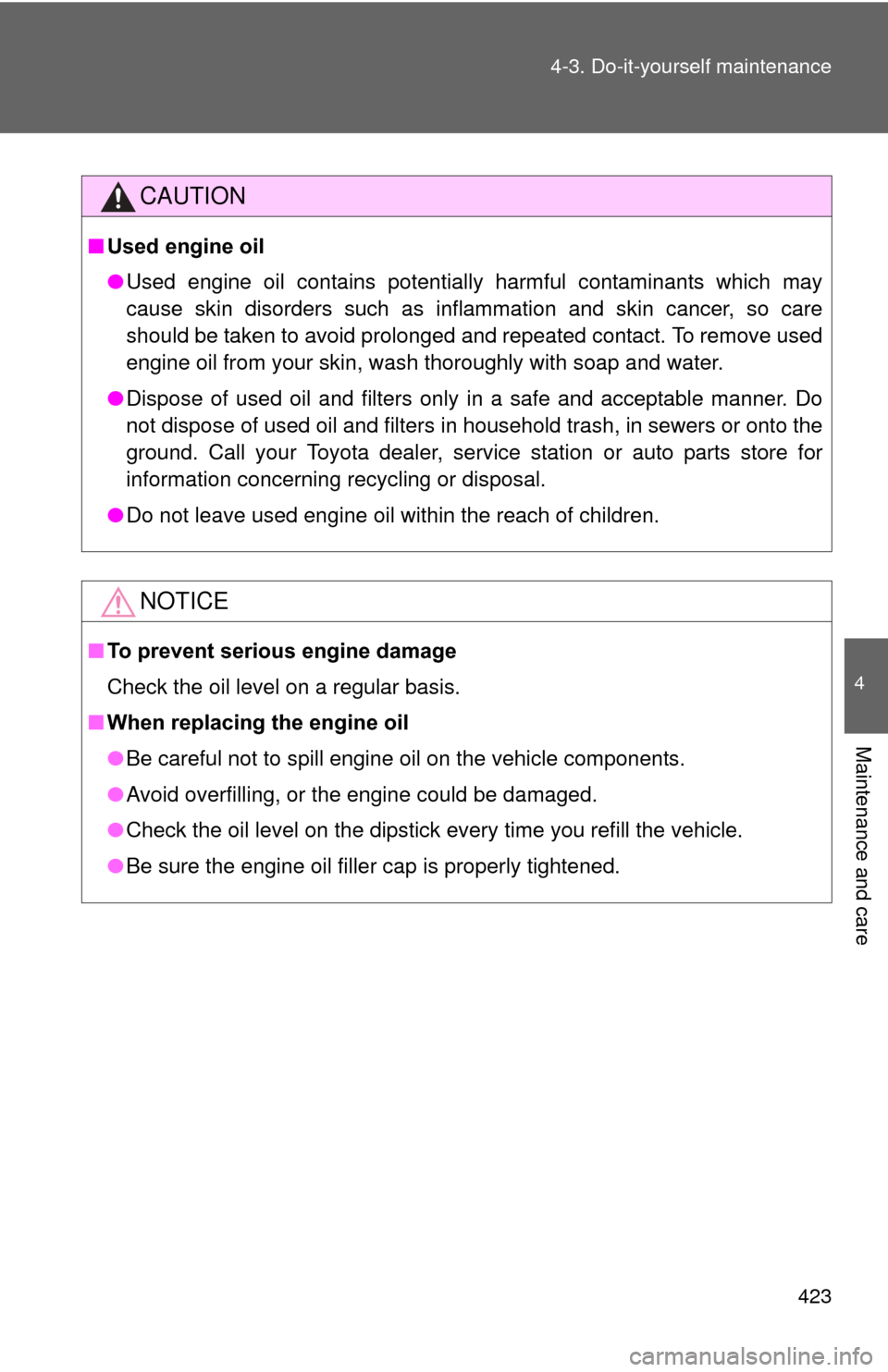Page 6 of 636
TABLE OF CONTENTSIndex
6
6-1. SpecificationsMaintenance data (fuel, oil level, etc.) ........... 560
Fuel information ................. 571
Tire information .................. 575
6-2. Customization Customizable features ....... 590
6-3. Initialization Items to initialize................. 597
Reporting safety defects for U.S. owners ................ 600
Seat belt instructions for Canadian owners
(in French) ........................ 601
SRS airbag instructions for Canadian owners
(in French) ........................ 603 Abbreviation list ............... 616
Alphabetical index ............ 618
What to do if... .................. 630
6Vehicle specifications
7For owners
Index
Page 405 of 636
405
4-2. Maintenance
4
Maintenance and care
General maintenance
Engine compartment
ItemsCheck points
Brake fluid Is the brake fluid at the correct
level? (
P. 427)
Engine/power control unit coolant Is the engine/power control unit
coolant at the correct level?
(P. 424)
Engine oil Is the engine oil at the correct
level?
(P. 420)
Exhaust system There should not be any fumes or
strange sounds.
Radiator/condenser The radiator and condenser
should be free from foreign
objects. (
P. 426)
Washer fluid Is there sufficient washer fluid?
(P. 429)
Listed below are the general maintenance items that should be per-
formed at the intervals specified in the “Owner’s Warranty Informa-
tion Booklet” or “Owner’s Manual Supplement/Scheduled
Maintenance Guide”. It is recomme nded that any problem you notice
should be brought to the attention of your Toyota dealer or qualified
service shop for advice.
Page 411 of 636
411
4-3. Do-it-yourself maintenance
4
Maintenance and care
ItemsParts and tools
Engine oil level (
P. 420)
• “Toyota Genuine Motor Oil” or
equivalent
• Rag or paper towel
• Funnel (used only for adding engine oil)
Fuses (P. 456)• Fuse with same amperage rating
as original
Light bulbs (P. 467)
• Bulb with same number and watt-
age rating as original
• Phillips-head screwdriver
• Flathead screwdriver
• Wrench
Radiator and condenser
(P. 426)
Tire inflation pressure ( P. 447)• Tire pressure gauge
• Compressed air source
Washer fluid ( P. 429)
• Water or washer fluid containing
antifreeze (for winter use)
• Funnel (used only for adding water or washer fluid)
Page 419 of 636
419
4-3. Do-it-yourself maintenance
4
Maintenance and care
Engine compar tment
■12-volt battery
P. 431
Engine coolant reservoir
( P. 424)
Engine oil level dipstick ( P. 420)
Engine oil filler cap ( P. 420)
Power control unit coolant
reservoir ( P. 424)Brake fluid reservoir
( P. 427)
Fuse box ( P. 456)
Radiator ( P. 426)
Condenser ( P. 426)
Electric cooling fans
Washer fluid tank ( P. 429)
Page 420 of 636
420 4-3. Do-it-yourself maintenance
Engine oilWith the engine at operating temperature and turned off, check the oil
level on the dipstick.
■ Checking the engine oil
Park the vehicle on level ground. After warming up the engine
and turning off the hybrid system, wait more than 5 minutes
for the oil to drain back into the bottom of the engine.
Holding a rag under the end, pull
the dipstick out.
Wipe the dipstick clean.
Reinsert the dipstick fully.
Holding a rag under the end, pull the dipstick out and check
the oil level.
Wipe the dipstick and reinsert it fully. Low
Full
STEP 1
STEP 2
STEP 3
STEP 4
STEP 5
STEP 6
ITO43P108
Page 421 of 636
421
4-3. Do-it-yourself maintenance
4
Maintenance and care
■
Adding engine oil
If the oil level is below or near
the low level mark, add engine
oil of the same type as that
already in the engine.
Make sure to check the oil type and prepare the items needed before
adding oil.
Remove the oil filler cap by turning it counterclockwise.
Add engine oil slowly, checking the dipstick.
Install the oil filler cap by turning it clockwise.
Engine oil selectionP. 564
Oil quantity
(Low Full) 1.6 qt. (1.5 L, 1.3 Imp.qt.)
Items Clean funnel
STEP 1
STEP 2
STEP 3
Page 422 of 636
422 4-3. Do-it-yourself maintenance
■Engine oil consumption
●The amount of engine oil consumed depends on the oil viscosity, the
quality of the oil and the way the vehicle is driven.
● More oil is consumed under driving conditions such as high speeds and
frequent acceleration and deceleration.
● A new engine consumes more oil.
● When judging the amount of oil consumption, keep in mind that the oil
may have become diluted, making it difficult to judge the true level accu-
rately.
● Oil consumption: Max. 1.1 qt./600 miles (1.0 L/1000 km, 0.9 Imp.qt./
600 miles)
● If your vehicle consumes more than 1.1 qt. (1.0 L, 0.9 Imp.qt.) every
600 miles (1000 km), contact your Toyota dealer.
Page 423 of 636

423
4-3. Do-it-yourself maintenance
4
Maintenance and care
CAUTION
■
Used engine oil
●Used engine oil contains potentially harmful contaminants which may
cause skin disorders such as inflammation and skin cancer, so care
should be taken to avoid prolonged and repeated contact. To remove used
engine oil from your skin, wash thoroughly with soap and water.
● Dispose of used oil and filters only in a safe and acceptable manner. Do
not dispose of used oil and filters in household trash, in sewers or onto the
ground. Call your Toyota dealer, service station or auto parts store for
information concerning recycling or disposal.
● Do not leave used engine oil within the reach of children.
NOTICE
■To prevent serious engine damage
Check the oil level on a regular basis.
■ When replacing the engine oil
●Be careful not to spill engine oil on the vehicle components.
● Avoid overfilling, or the engine could be damaged.
● Check the oil level on the dipstick every time you refill the vehicle.
● Be sure the engine oil filler cap is properly tightened.